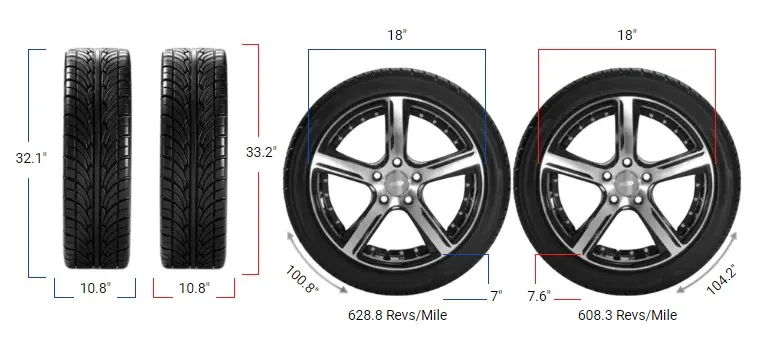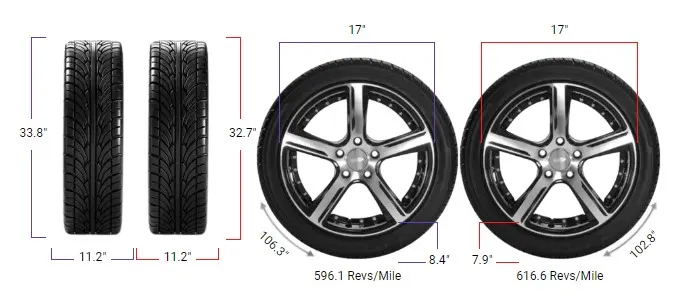Tire Size 235/40r18 vs 225/40r18
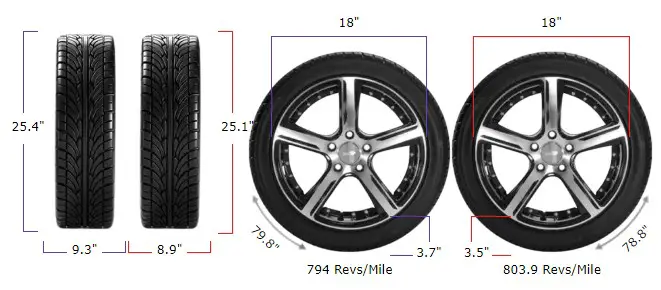 Switching from 235/40R18 to 225/40R18 might seem like a small change, but it can significantly impact how your vehicle performs. Understanding these differences helps ensure you make an informed choice.
Switching from 235/40R18 to 225/40R18 might seem like a small change, but it can significantly impact how your vehicle performs. Understanding these differences helps ensure you make an informed choice.
- Improved fuel efficiency due to lower rolling resistance
- Slightly reduced ground clearance, which may affect off-road capability
- Enhanced handling with a narrower tire width for better road grip
- Slightly stiffer ride due to reduced sidewall height
- Slightly quicker tread wear due to narrower contact patch
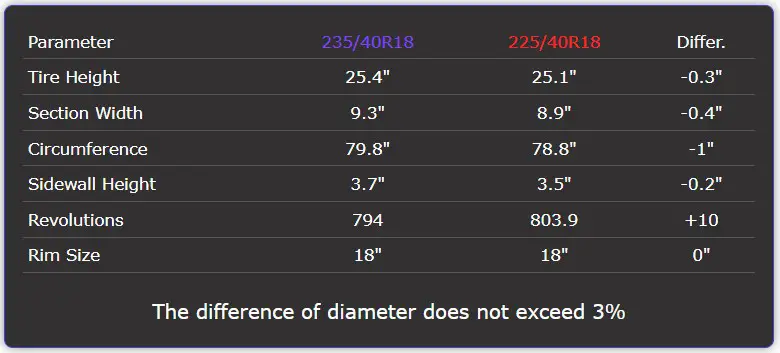
Fitment Guide
The 235/40R18 has a diameter of 25.4 inches, while the 225/40R18 measures 25.09 inches—a 1.2% decrease.
This is well within the acceptable range, meaning these tires can be switched without causing serious problems. However, if you push beyond the 3% limit, you may run into issues like rubbing against the fenders or suspension components.
If the difference had exceeded the acceptable limit, modifications such as spacers or fender adjustments would be necessary to ensure proper fitment.
On-Road & Off-Road Impact
Switching from 235/40R18 to 225/40R18 will influence the car’s performance both on-road and off-road.
While on-road impacts might be more noticeable in handling and ride comfort, off-road differences can appear in areas like ground clearance and durability.
Below, we’ll dive into how each of these tire sizes performs in key areas for both on-road and off-road driving.

Ground Clearance
The 235/40R18 provides a ground clearance of 3.7 inches, whereas the 225/40R18 offers 3.54 inches of clearance. This difference of 0.16 inches is minimal and won’t noticeably affect driving on paved roads.
However, in off-road situations, every bit of clearance matters, so the slight reduction might cause minor issues when navigating rough terrain or obstacles like rocks and logs.
Gas Mileage
A smaller tire width typically reduces rolling resistance, meaning the 225/40R18 may slightly improve your vehicle’s fuel efficiency compared to the wider 235/40R18.
The difference, however, is likely to be minimal, and you might notice only a small improvement in gas mileage on the highway or during city driving.
Aesthetic Look
Visually, the 235/40R18 tire has a bulkier, sportier look due to its wider stance, while the 225/40R18 will have a slightly sleeker appearance.
For some drivers, the wider tire offers a more aggressive aesthetic, which can make the car look more performance-oriented. If looks are a key factor for you, this is something to consider when switching.

Ride Comfort
The 225/40R18 tire has a lower sidewall height than the 235/40R18—3.54 inches compared to 3.7 inches.
While this difference is small, it can result in a slightly stiffer ride since there’s less tire to absorb road imperfections.
However, most drivers will find the difference in comfort negligible unless driving on extremely rough roads.
Speedometer Accuracy
The smaller diameter of the 225/40R18 will slightly affect your speedometer readings. When your speedometer reads 20 mph, you’ll actually be traveling at 19.75 mph.
This is a 1.3% discrepancy, which is minimal but worth noting if precision is important to you. In most cases, this difference won’t affect everyday driving, but if you’re often traveling at highway speeds, you might notice a slight deviation.
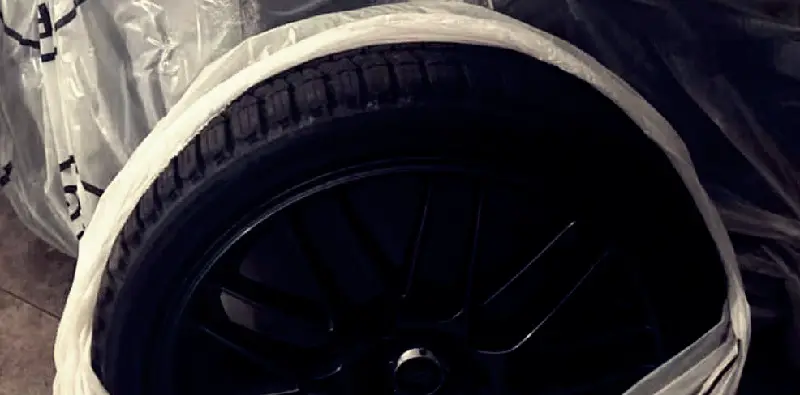
Durability & Wear
A narrower tire like the 225/40R18 generally has less rubber contacting the road, which can lead to faster tread wear compared to the 235/40R18.
Additionally, the 225/40R18 may be more prone to wear on rougher surfaces, making it a slightly less durable option for those who frequently drive on uneven or off-road terrains.
Difference Between 235/40R18 and 225/40R18
The main difference between 235/40R18 and 225/40R18 is the tire width. The 235 size is 0.39 inches wider than the 225 size, affecting handling and appearance.
235/40r18 vs 225/40r18
| Feature | 235/40R18 | 225/40R18 | Difference |
|---|---|---|---|
| Diameter inches (mm) | 25.4 (645.2) | 25.09 (637.2) | -0.31 (-8) -1.2% |
| Width inches (mm) | 9.25 (235) | 8.86 (225) | -0.39 (-10) -4.3% |
| Circumference inches (mm) | 79.8 (2026.96) | 78.81 (2001.82) | -0.99 (-25.13) -1.2% |
| Sidewall Height inches (mm) | 3.7 (94) | 3.54 (90) | -0.16 (-4) -4.3% |
| Revolutions per mile (km) | 793.97 (493.35) | 803.94 (499.54) | 9.97 (6.19) +1.3% |
| Speedo Reading (20 mph) | 20 mph (32.19 km/h) | 19.75 mph (31.79 km/h) | -0.25 mph |
Can I Use 225/40R18 Instead of 235/40R18?
Yes, you can use 225/40R18 instead of 235/40R18. The diameter difference is within the recommended 3% range, so it should fit without major issues, but check for any clearance problems.
How Much Taller Is a 235/40R18 Tire Than a 225/40R18?
The 235/40R18 tire is 0.31 inches taller than the 225/40R18. This small height difference won’t significantly impact most vehicles’ performance or handling.
How Much Wider Is a 235/40R18 Tire Than a 225/40R18?
The 235/40R18 tire is 0.39 inches wider than the 225/40R18. This width difference affects the tire’s grip, handling, and appearance on your vehicle.
Our Observation
Switching from 235/40R18 to 225/40R18 comes with both benefits and drawbacks, though most differences are small enough to be negligible for the average driver.
On-road, the 225/40R18 may offer a slight improvement in fuel efficiency and a more compact appearance. However, the narrower width and shorter sidewall height may lead to a slightly rougher ride and quicker tread wear.
The differences in ground clearance and speedometer accuracy are minimal and won’t significantly affect performance, whether you’re on paved roads or venturing off-road.
Ultimately, while the change is minor, those looking for the best balance between performance and comfort might prefer sticking with the wider 235/40R18, particularly if they value a sportier look and feel.


